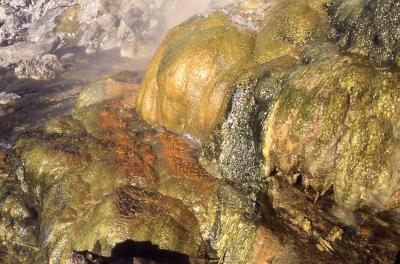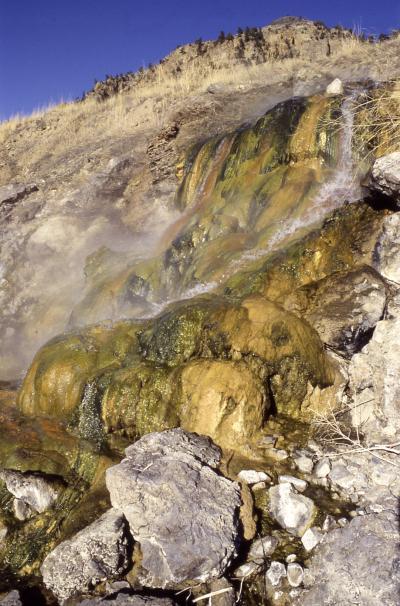Bacteria growing in near darkness can still harvest energy and produce oxygen from sunlight.
Researchers discovered that the cyanobacterial strain Leptolyngbya completely changes its photosynthetic apparatus in order to use far-red light, which has wavelengths longer than 700 nanometers - longer than the range of light that most people can see. Their experiments revealed that these cyanobacteria replace seventeen proteins in three major light-using complexes while also making new chlorophyll pigments that can capture the far-red light, and while using pigments called bilins in new ways.
The scientists also discovered that the organisms accomplish this feat by quickly turning on a large number of genes to modify cellular metabolism and simultaneously turning off a large number of other genes -- a process that they have named Far-Red Light Photoacclimation (FaRLiP).

This photo shows the colors of the Leptolyngbya sp. strain of cyanobacteria cells (JSC-1) collected from a hot spring near Yellowstone National Park by Donald A. Bryant when grown in white fluorescent light (WL), green-filtered fluorescent light (GL), red light provided by 645-nm LEDs, or far-red light provided by 710-nm LEDs. Cyanobacteria are known to appear brown when they are grown in green light and to appear blue-green when they are grown in red light. Although the cells grown in red light and far-red light look similar, Bryant's research shows that the photosynthetic apparatus in these two cell types is quite different and is optimized to use light wavelengths longer than 700 nm. Credit: Donald A. Bryant lab, Penn State University
"We have shown that some cyanobacteria, also called blue-green algae, can grow in far-red wavelengths of light, a range not seen well by most humans," said Donald A. Bryant, the Ernest C. Pollard Professor of Biotechnology and a professor of biochemistry and molecular biology at Penn State. "Most cyanobacteria can't 'see' this light either. But we have found a new subgroup that can absorb and use it, and we have discovered some of the surprising ways they manipulate their genes in order to grow using only these wavelengths," he said.
Because the genes that are turned on are the genes that determine which proteins the organism will produce, this massive remodeling of the available gene profile has a dramatic effect.
"Our studies reveal that the particular cyanobacterium that we studied can massively change its physiology and metabolism, and its photosynthetic apparatus," Bryant said. "It changes the core components of the three major photosynthetic complexes, so one ends up with a very differentiated cell that is then capable of growing in far-red light. The impact is that they are better than other strains of cyanobacteria at producing oxygen in far-red light, and they are better even than themselves. Cells grown in far-red light produce 40 percent more oxygen when assayed in far-red light than cells grown in red light assayed under the same far-red light conditions."
To make these discoveries, Bryant's team used a variety of biological, genetic, physical, and chemical experiments in order to learn how this unusual photosynthesis system works as a whole. The team's investigations includes biochemical analyses, spectroscopic analyses, studies of the structures and functions of proteins, profiles of gene-transcription processes, and sequencing and comparisons of cyanobacteria genomes. "Our genome-sequence analyses of different cyanobacteria strains revealed 13 additional strains that also appear to be able to use far-red light for photosynthesis," Bryant said.

A close view of a benthic microbial mat community at the LaDuke hot spring in Gardiner, Montana near Yellowstone National Park, showing cyanobacteria and other chlorophototrophic bacteria. Credit: Donald A. Bryant lab, Penn State University
The Leptolyngbya cyanobacterial strain that Bryant's team studied is one that was collected at LaDuke hot spring in Montana, near Yellowstone National Park. This strain was living on the underside of a 2-milimeter-thick mat that is so dense with bacteria that only the far-red wavelengths of light can penetrate to the bottom. Another environment where understanding photosynthesis in far-red light may have important implications is in the surface crusts of deserts and other soils, which cover a large percentage of the Earth's surface. "It is important to understand how this photosynthetic process works in global-scale environments where cyanobacteria may be photosynthesizing with far-red light, in order to more fully understand the global impact of photosynthesis in oxygen production, carbon fixation, and other events that drive geochemical processes on our planet," Bryant said.

LaDuke hot spring in Gardiner, Montana, along the Yellowstone River, near Yellowstone National Park. The images show the rich mat community of chlorophototrophic bacteria that grow along the hot spring's effluent channel. The dark-green-colored organisms are mainly cyanobacteria. Credit: Donald A. Bryant lab, Penn State University
The research raises questions about the possibility of introducing into plants the capacity to use far-red wavelengths for photosynthesis. But Bryant said much more basic research is required first. "Our research already has shown that it would not be enough to insert a new far-red-light-absorbing pigment into a plant unless you also have the right protein scaffolds to bind it so that it will work efficiently. In fact, it could be quite deleterious to just start sticking long-wavelength-absorbing chlorophylls into the photosynthetic apparatus," he said.
"We now have clearly established that photosynthesis can occur in far-red light, in a wavelength range where people previously did not think that oxygenic photosynthesis could take place, and we have provided details about many of the processes involved. Now there are a whole set of associated scientific questions that need to be answered about more of the details before we can begin to investigate any applications that may or may not be possible," Bryant said. "Our research has opened up many new questions for basic scientific research."






Comments